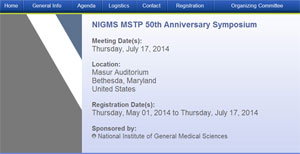 This year is the 50th anniversary of the NIGMS Medical Scientist Training Program (MSTP), which supports research training leading to the combined M.D.-Ph.D. (or other dual) degree. Starting with only three institutions and a handful of supported students, the program has grown to 45 institutions and more than 900 trainees per year.
This year is the 50th anniversary of the NIGMS Medical Scientist Training Program (MSTP), which supports research training leading to the combined M.D.-Ph.D. (or other dual) degree. Starting with only three institutions and a handful of supported students, the program has grown to 45 institutions and more than 900 trainees per year.
We’re marking this milestone year with a symposium on Thursday, July 17, from 8:00 a.m.-12:00 p.m. on the NIH campus in Bethesda, MD. The event will feature remarks by NIH Director Francis Collins and Association of American Medical Colleges President and CEO Darrell Kirch as well as talks by seven current and former MSTP trainees.
Although the symposium is free, we would like participants to register to attend. If you can’t join us in person, you can watch the event live online.
Plans for a scholarly article highlighting the history of the MSTP are under way. If you have comments, anecdotes, historical data, photos or other relevant images, please let us know by writing a note in the comments box on the meeting registration site or by sending me an e-mail message.


In the late 60’s and 70’s, when the MSTP was young, it was nurtured by Vince Price, the first NIGMS MSTP director, and later Lee Van Lenten and Bert Shapiro, who each took a personal interest in not only the individual programs but also the students themselves. Under the direction of Bob Schimke, the Stanford Program started small and chose students who were already medical students. The PhD was not thought to be necessary, but the research projects were required to be of PhD quality. The directorship was passed to Merton Bernfield and then in 1978 to David Clayton, who remained Director until 1996. The ensuing years have seen Mark Krasnow, Greg Barsh, Seung Kim, and P.J. Utz holding the Directorship.
The Programs were well-funded up until the mid 70’s, and each student was paid a stipend (unsupplemented!), full tuition, travel funds, and of all things, a supply budget…usually around $1000 per student (in l970, that bought a great deal more pipettes than in 2014). We sometimes had to scramble at the end of the grant year to make sure all the supply funds had been used.
In 1976-77, the NRSA was formed, the budgets were restructured, and the PhD became mandatory and the MSTP became an MD/PhD program. It was at this point that the MSTP directors felt admission to the program should interface with medical school admissions and that structure has remained intact throughout the continuing years of the MSTP.
What made the MSTP at Stanford so appealing to that particular generation of bright young students was the availability of a wide variety of faculty advisors who offered training in state-of-the-art labs, and whose dedication to expanding the horizons of basic medical science presented opportunities for interesting and successful research projects for students. Because the Program was relatively small (5-7 new students per year), the admissions process could be very selective from a pool of exceptionally well-qualified applicants. From the beginning, the strength of the Program was founded in the matching of the student and faculty advisor. Although it was a choice made between student and faculty, the MSTP Directors guided those training decisions very carefully.
The great pleasure in associating with these students over 6 or 7 years was finding that they were without exception not only gifted scientists but that they also had a diverse range of other talents. So, we have had concert musicians, Olympic quality athletes, and garden-variety comedians among other things. This was not a program of narrow interests, but one of very balanced students taking advantage of all that life had to offer.
The ‘proof of the pudding’ of course has always been ‘what have these students done with the training received with MSTP’? And that has been a source of significant pride for those of us privileged to work with this talented group of trainees. Most of our graduates continued postgraduate training and went on to academic research and leadership positions that maximized their contributions to medical science, which was the original intent of the MSTP; namely, to provide a pool of physician-scientists to advance the field of basic medical knowledge.